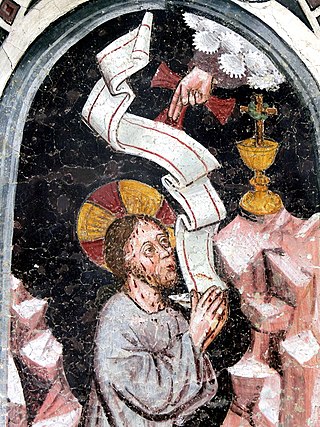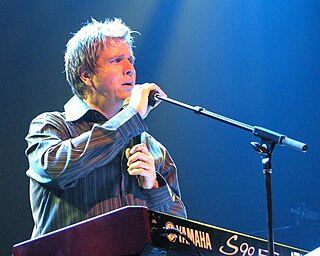Related Research Articles
Pentecostalism or classical Pentecostalism is a Protestant Charismatic Christian movement that emphasizes direct personal experience of God through baptism with the Holy Spirit. The term Pentecostal is derived from Pentecost, an event that commemorates the descent of the Holy Spirit upon the Apostles and other followers of Jesus Christ while they were in Jerusalem celebrating the Feast of Weeks, as described in the Acts of the Apostles.

A spiritual gift or charism is an extraordinary power given by the Holy Spirit. These are believed by followers to be supernatural graces that individual Christians need to fulfill the mission of the Church. In the narrowest sense, it is a theological term for the extraordinary graces given to individual Christians for the good of others and is distinguished from the graces given for personal sanctification, such as the Seven Gifts of the Holy Spirit and the fruit of the Holy Spirit.
Wayne Hughes is a New Zealand former Pentecostal minister. Until early 2005, he was the senior pastor of the Takapuna Assembly of God in Auckland. A photographer by training, Hughes became pastor of the Takapuna Assembly of God in 1975. Under his leadership spanning three decades, it grew from 25 members to about 1600 adherents as of 2005. About a third of these are formal members.

The Pensacola News Journal is a daily morning newspaper serving Escambia and Santa Rosa counties in Florida. It is Northwest Florida's most widely read daily.

The Toronto Blessing, a term coined by British newspapers, refers to the Christian revival and associated phenomena that began in January 1994 at the Toronto Airport Vineyard church (TAV), which was renamed in 1996 to Toronto Airport Christian Fellowship (TACF) and then later in 2010 renamed to Catch the Fire Toronto. It is categorized as a neo-charismatic Evangelical Christian church and is located in Toronto, Ontario, Canada. The revival impacted charismatic Christian culture through an increase in popularity and international reach and intensified criticism and denominational disputes. Criticism primarily centered around disagreements about charismatic doctrine, the Latter Rain Movement, and whether or not the physical manifestations people experienced were in line with biblical doctrine or were actually heretical practices.
The Latter Rain, also known as the New Order or the New Order of the Latter Rain, was a post–World War II movement within Pentecostal Christianity which remains controversial. The movement saw itself as a continuation of the restorationism of early pentecostalism. The movement began with major revivals between 1948 and 1952 and became established as a large semi-organized movement by 1952. It continued into the 1960s. The movement had a profound impact on subsequent movements as its participants dispersed throughout the broader charismatic and pentecostal movements beginning in the 1960s.

William Marrion Branham was an American Christian minister and faith healer who initiated the post-World War II healing revival, and claimed to be a prophet with the anointing of Elijah, who had come to prelude Christ's second coming; some of his followers have been labeled a "doomsday cult". He is credited as "a principal architect of restorationist thought" for charismatics by some Christian historians, and has been called the "leading individual in the Second Wave of Pentecostalism." He made a lasting influence on televangelism and the modern charismatic movement, and his "stage presence remains a legend unparalleled in the history of the Charismatic movement".

Marilyn Allene Hickey is an American Christian minister and televangelist who teaches Bible studies both nationally and internationally.

Rodney Morgan Howard-Browne is a South African-born American evangelist and conspiracy theorist. He has resided in Tampa, Florida since the mid-1990s and is pastor of The River Church in Tampa Bay. The River is considered both Pentecostal and Charismatic with revival meetings, led by Howard-Browne, known for those in the audience breaking into "holy laughter" and experiencing other phenomena similar to the Great Awakenings and Azusa Street Revival. Howard-Browne is the head of Revival Ministries International, a ministry he and his wife founded in 1997.
Steve Hill was an American Christian clergyman and evangelist. He is best known as the evangelist who preached in what became known as the Brownsville Revival. It was a series of meetings at Brownsville Assembly of God in Pensacola, Florida that began on Father's Day, 1995 and continued for five years. In 2000, Hill moved to the Dallas/Fort Worth area in Texas to resume traveling evangelism. In 2003, he founded Heartland Family Church in the Las Colinas section of Irving, Texas, a suburb of Dallas.

Carpenter's Home Church was a prominent Pentecostal megachurch in Lakeland, Florida, affiliated with the Assemblies of God USA. Opened in 1985, the church claimed nearly 7,000 worshipers at its peak. The church closed amidst financial scandal and dwindling attendance. The remaining members became two separate congregations, one of which became prominent as the host of the Lakeland Revival in 2008. The property was purchased by Without Walls International Church of Tampa, Florida, and the facility became the home of their affiliate Without Walls Central Church. Without Walls experienced financial difficulties requiring them to sell their properties. The building was eventually acquired by developers and demolition commenced in March 2015. Today, nothing remains of the building.

The Assemblies of God USA (AG), officially The General Council of the Assemblies of God, is a Pentecostal Christian denomination in the United States founded in 1914 during a meeting of Pentecostal ministers at Hot Springs, Arkansas, who came from a variety of independent churches and networks of churches. The Assemblies of God is a Finished Work Pentecostal denomination and is the U.S. branch of the World Assemblies of God Fellowship, the world's largest Pentecostal body. With a constituency of 2,928,143 in 2022, the Assemblies of God was the ninth largest Christian denomination and the second largest Pentecostal denomination in the United States.

Todd David Bentley is a Canadian Christian evangelist. He was a key figure of the Lakeland Revival and was in leadership of Fresh Fire Ministries Canada until stepping down in August 2008 following accusations of immoral behavior.
The Lakeland Revival, or Florida Healing Outpouring, was a Pentecostal revival which took place from April until October 2008 in Lakeland, Florida, United States. The revival began on April 2, 2008, when evangelist Todd Bentley of Fresh Fire Ministries Canada was invited by Stephen Strader, pastor of Lakeland's Ignited Church, to lead a one-week revival, but remained there for over four months.

Bethel Church is an American non-denominational neo-charismatic megachurch in Redding, California with over 11,000 members. The church was established in 1952, and is currently led by Bill Johnson. Bethel has its own music labels, Bethel Music and Jesus Culture ministries, which have gained popularity for contemporary worship music. The church runs the Bethel School of Supernatural Ministry with over 2,000 students annually.
The Bay Revival is a spiritual awakening of the Christian faith that started at the Church of His Presence in Daphne, Alabama, in July 2010, and after April 2011 expanded to global telecasts. It had grown to become a weekly event that was held for a period of nine months in Mobile, Alabama, before taking to the road to tour other U.S. cities. The revival has been led by John Kilpatrick, pastor of the Church of His Presence and Nathan Morris of "Shake the Nations" in Great Britain. The meetings have been characterized by extended periods of worship led by Lydia Stanley, sermons challenging people to turn back to God, prayer for the sick, and claims of divine healing that have been widely publicized. It has also gained attention via an international television audience.

Lindell Cooley is a pastor, Christian singer and was worship leader of the Brownsville Revival in Pensacola, Florida.

Bill Johnson is the senior leader of Bethel Church, a charismatic megachurch in Redding, California. The congregation has grown in membership from 2,000 when he joined in 1996, to over 11,000 in 2019. Johnson has taken public conservative positions on same-sex marriage, abortion, open borders, and many other topics. He is an author, functions as an itinerant speaker and has been featured in various media.
Ward Simpson is a businessman, Bible teacher and media executive. He was appointed president and CEO of GOD TV on 1 October 2016. Originally from Barbados, he has lived in the United States for 20 years.
The Smithton Revival was a Pentecostal Christian revival meeting that occurred in the small town of Smithton, Missouri, from March 24, 1996 to April 2000. A small congregation of about 180 people, Smithton Community Church, hosted steady crowds for three years resulting in over 250,000 visitors.
References
- 1 2 3 "Pastor orchestrated first revival". The Pensacola News Journal. November 19, 1997. Archived from the original on 2008-06-07. Retrieved 2008-07-16.
- 1 2 3 4 5 "Fire From Above". Charisma Magazine. June 2005. Retrieved 2012-02-12.
- ↑ Steve Rabey as quoted in Margaret M. Poloma and John C. Green (2010). The Assemblies of God: Godly Love and the Revitalization of American Pentecostalism. New York: New York University Press. ISBN 978-0-8147-6783-2. Page 1.
- 1 2 3 "Timeline of the Revival at Brownsville". RevivalatBrownsville.com. 2006. Retrieved 2008-07-16.
- ↑ "No medical proof of 'miraculous healings'". Pensacola News Journal. November 20, 1997. Archived from the original on 2008-06-07. Retrieved 2008-07-16.
- ↑ "On the road: Pleas for money intensify". The Pensacola News Journal. November 16, 1997. Archived from the original on 2008-06-07. Retrieved 2008-07-16.
- ↑ "Heartland World Ministries Church" . Retrieved 2008-07-16.
- ↑ "Steve Hill Passes Away After Miraculous Life" . Retrieved 2014-06-06.
- ↑ "Church History". Brownsville Assembly of God. 2008. Retrieved 2008-07-16.[ permanent dead link ]
- ↑ "Brownsville Revival: Five Years Later 2". cbn.com. Archived from the original on 2008-07-11. Retrieved 2008-07-17.
- ↑ "Follow the Fire" book by Steve Gray, foreword by Pat Robertson, published by Charisma House, 2001.
- ↑ "Charisma Magazine".
- ↑ "Brownsville Revival:The Money and the Myths". Pensacola News Journal. November 16–20, 1997. Archived from the original on 2008-06-22. Retrieved 2008-07-16.
- ↑ "Pensacola Pursued Brownsville Revival Investigation in Two Steps". Gannett.com. 2008. Archived from the original on 1999-10-21. Retrieved 2012-02-12.
- ↑ "Official Brownsville Response To Pensacola News Journal Articles". 1997. Retrieved 2009-08-31.
- ↑ The Counterfeit Revival (Part Three) Separating Fact from Fabrication on the Pensacola Outpouring.
- ↑ "www.fireinmybones.com/Columns/051906.html".